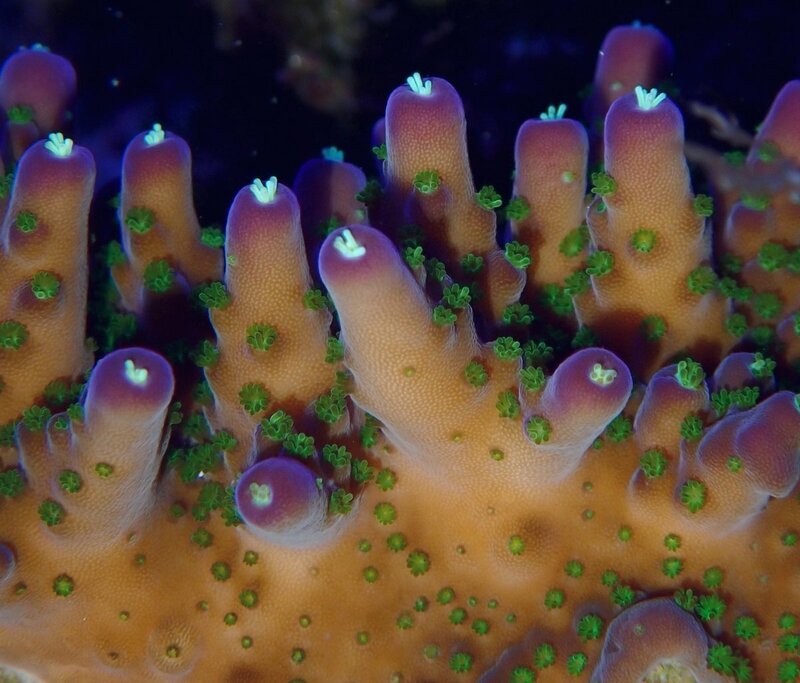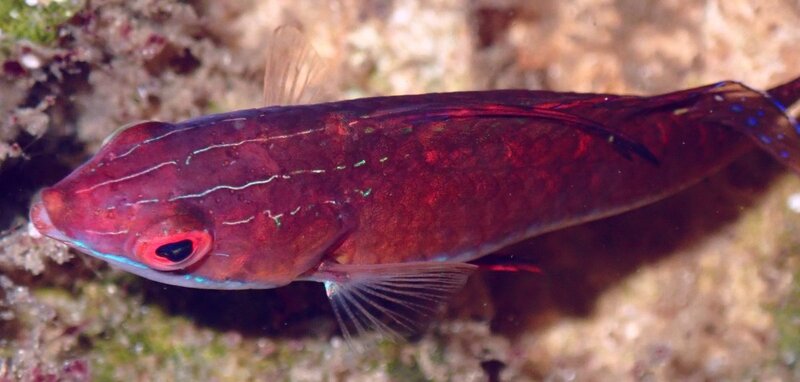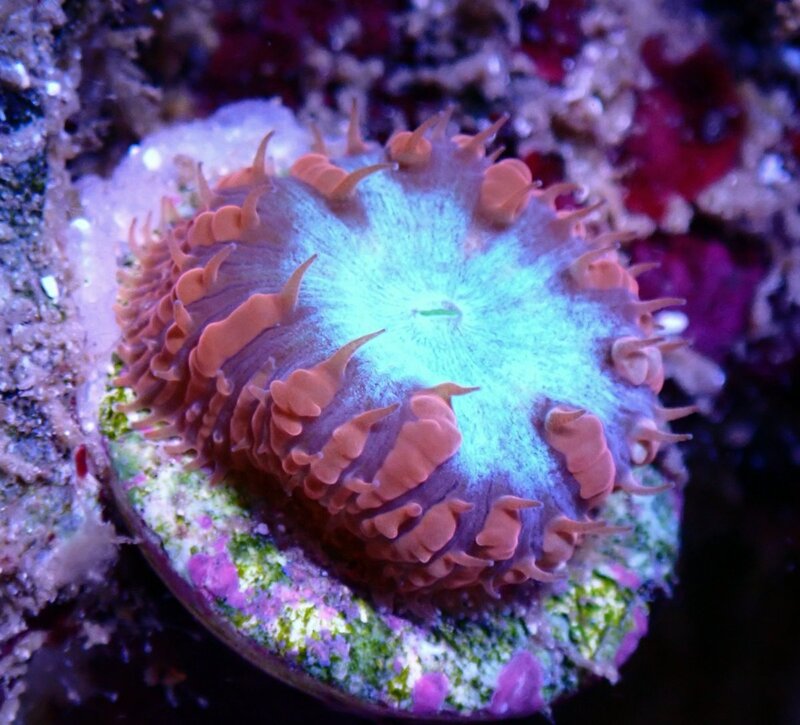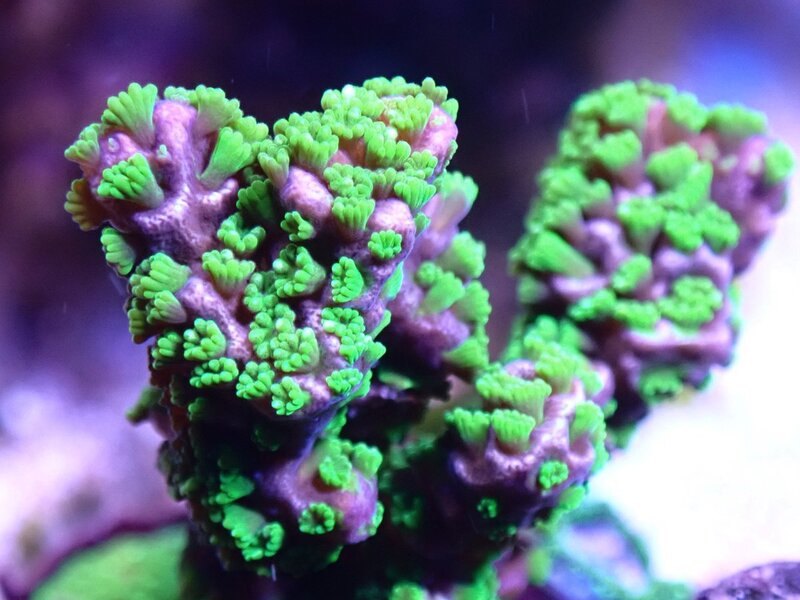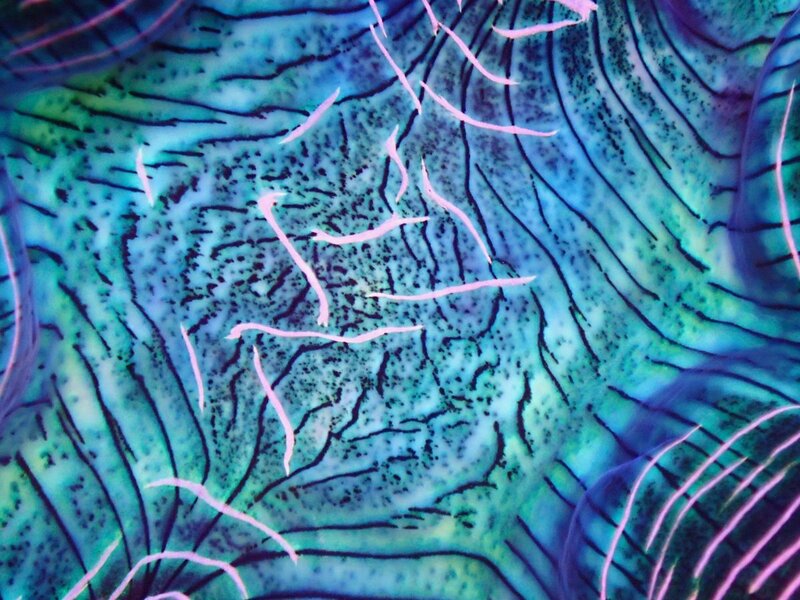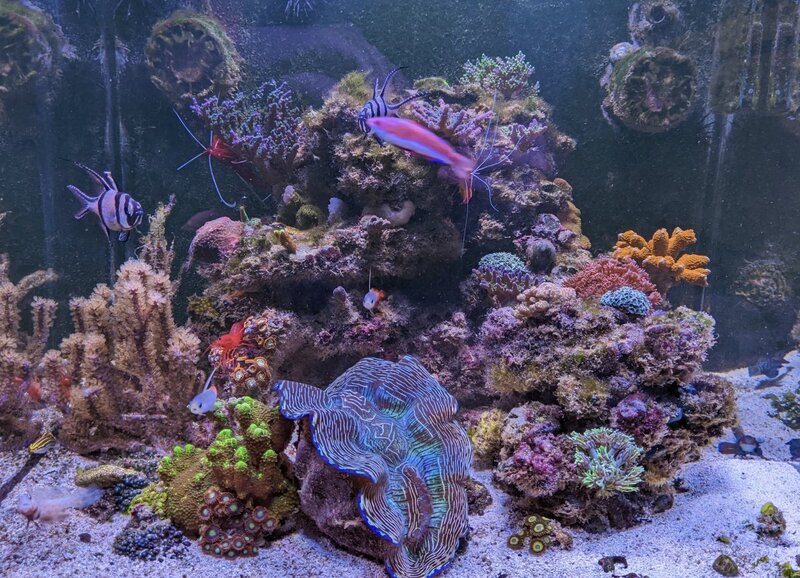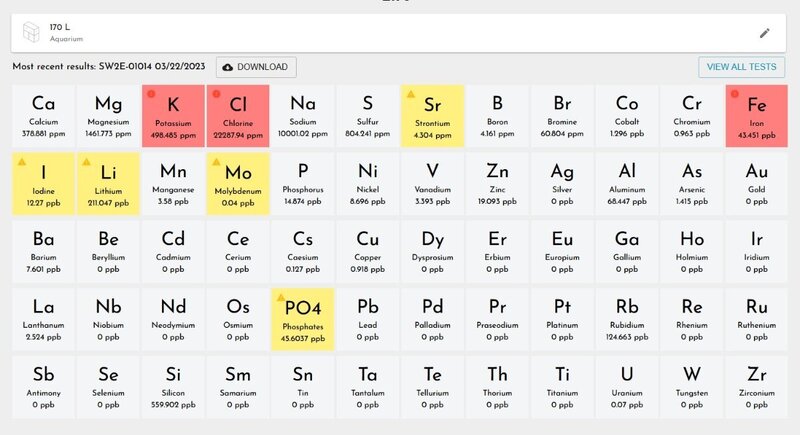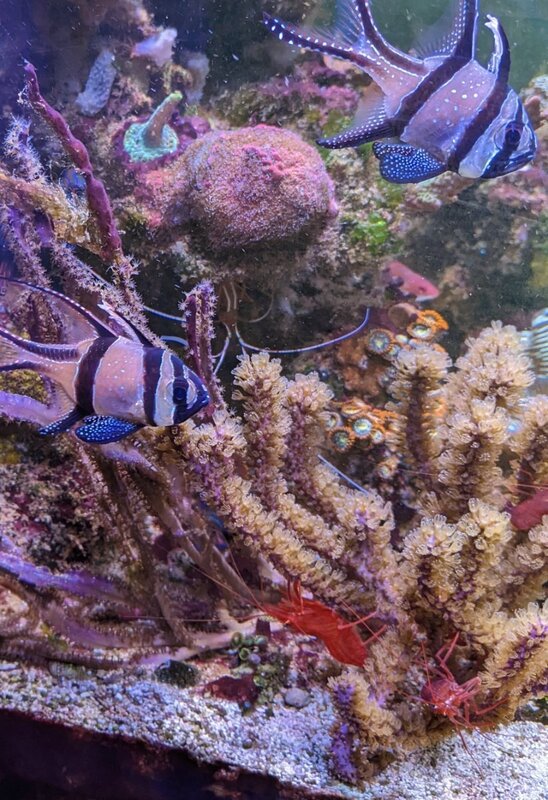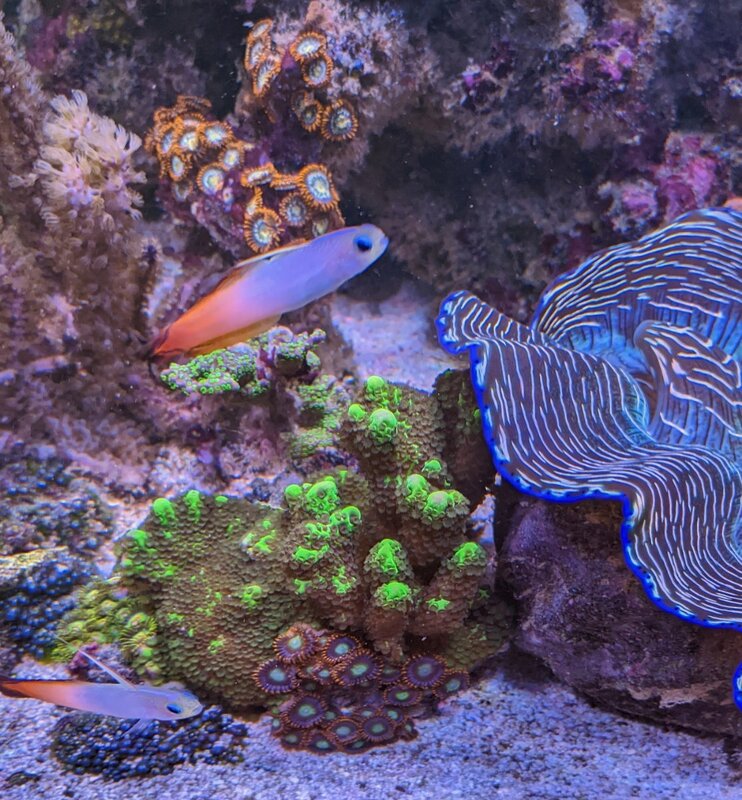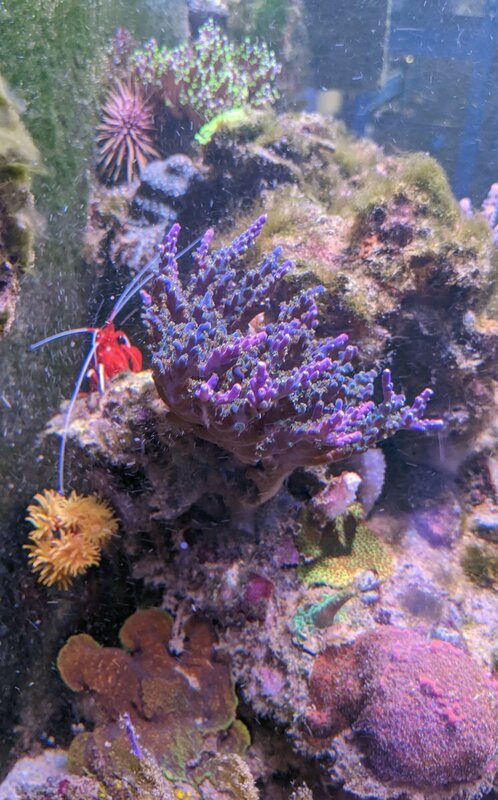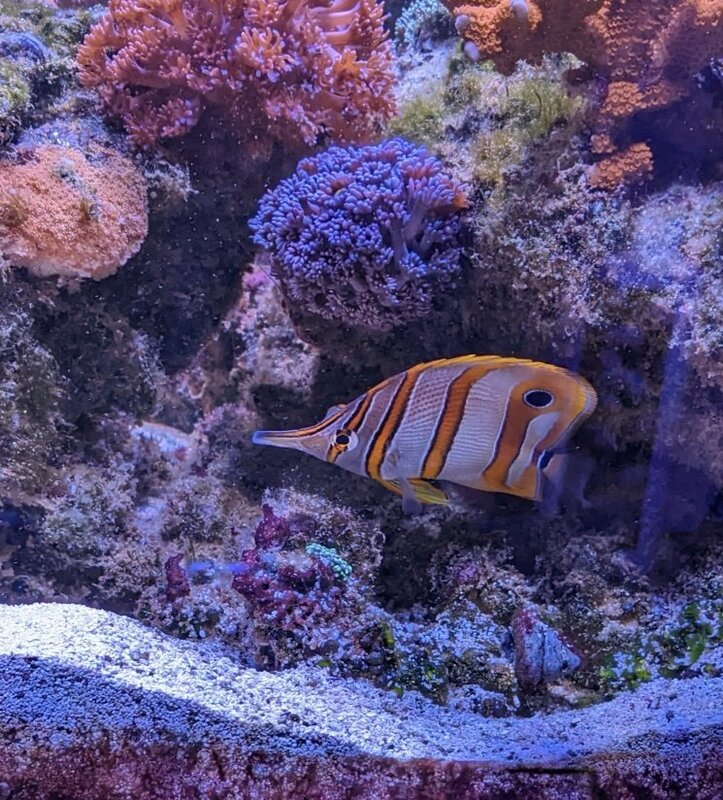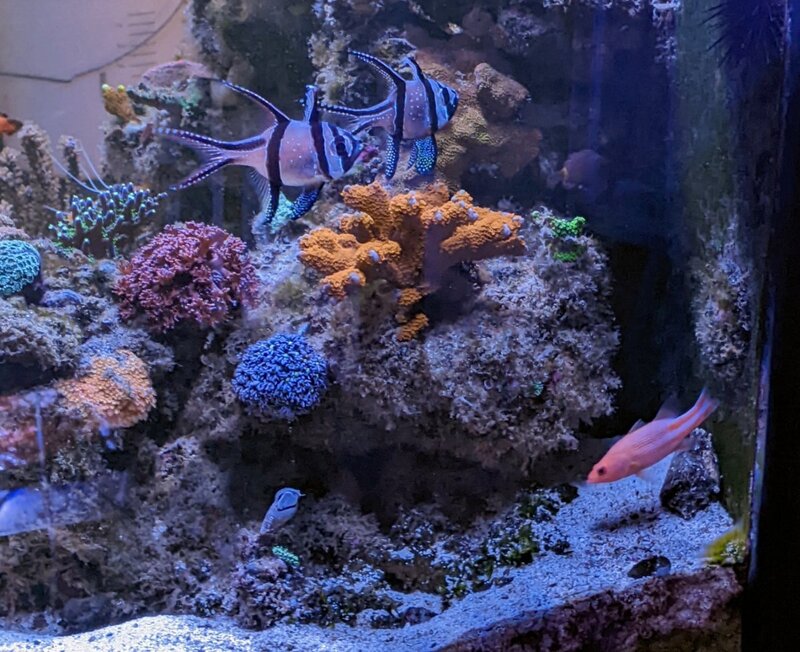-
Posts
748 -
Joined
-
Last visited
Content Type
Profiles
Forums
Gallery
Events
Store
Everything posted by DaJMasta
-
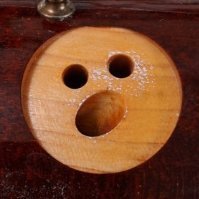
really quiet return pump reccommendations
DaJMasta replied to astroboy's topic in General Discussion
Another option is a Sicce Silent line pump - even their AC pumps are quite quiet, generally, and they've got the history to backup their reliability. Worth mentioning: the energy savings isn't as straightforward as it seems, as what's burned in an AC pump just gets put into the water at heat, which in most cases, means your heaters run less. Now if it's already running on the high side, it can help, and the ability to vary the flow without a valve is a useful one, but unless you need the heat out of your system, what you save on the pump will likely be made up by the heaters. -

Shrimp surgery: removing a parasitic isopod
DaJMasta replied to DaJMasta's topic in General Discussion
Did the same basic procedure on another shrimp, this time an Urocaridella antonbruunii, and got it on video. He's doing well! -
Lots of activity, not a lot of success. I can get larvae generally to day 5 or so and then they don't last, and that was a common early dieoff period before. It could be feeding - my cultures may have been cross contaminated and I may not have the right copepods, but my current assumption is that I've been over feeding, so I've got some (maybe a dozen) at 2 days post hatch right about now, and will start feeding this evening, but something like 1/2 or 1/3 of the previous few attempts, and then emphasizing water changes with any discoloration of the water. Lots of subtle changes to the vessels used and the overall approach, and then some delays from trying other things and just the time required to reset a vessel, which is now shortened for using smaller containers. Hopefully I can find the right balance soon, but if nothing else, I've got plans to check and refresh my copepod cultures in the next few weeks too.
-
Haven't tried, but I would doubt it. That sounds basically like a more traumatic version of polyp bailout in other LPS, and it's quite rare for another coral that bails from its skeleton to be able to live, let alone one that was cut out of it.
-
I don't know what there is to upgrade - are you having problems with anything in particular? An O ring replacement and full cleanout of the pipes would probably do a fair bit of good, but if you're actually replacing things, I believe all of Red Sea's plumbing is metric dimensions, so sourcing parts will be trickier than just going to the big box shop.
-
If you can get something acidic to stay in place for a while, it should do the job, but have you tried just a razor blade? Steel is softer than glass, so it's safe to do (but rusts real quick if there's actual saltwater in there).
-
The magnesium is quite high for sure, but if it actually is elevated, since calcium is somewhat elevated and alkalinity isn't low, I'd consider recalibrating your refractometer and remeasuring salinity - it could be a higher value than you're currently seeing.
-

What's the best way to start dosing kalk??
DaJMasta replied to tonkadawg's topic in General Discussion
From their website, up to 2 cups can be added to the K1. https://www.avastmarine.com/products/kalk-stirrer Personally, I would stay well away from the output line's height to make sure what you're dosing is saturated lime water and not slurry, and if you can estimate your throughput of water through the system, you know that you'll consume about 2 teaspoons per gallon of RO through to give you an idea of how long a given amount added should last. As for the calculation, you can use a one-time dosing calculator to find out how much dKH and ppm of calcium your current dosing increases your volume by, then try to match that with a lime water dosing calculator, but my guess is you are using more alkalinity than calcium, so you may still have to supplement a little bit if that is indeed the balancing point. I would initially start lower, but I wouldn't be surprised if you could dose a liter a day as a starting point and still need to up it after testing. -

DaJMasta's 45G AIO Cube Mixed Reef
DaJMasta replied to DaJMasta's topic in Dedicated Tank (Build) Forum
I don't know how available the skimmer I'm using is, I think it was discontinued the year before I got it, and it's not quite the same dimensions as the newer K1 Nano (I think that's what it's called), which may not fit - the fit on this one is tight as is. I actually wanted a Tunze 9004 DC (I think the 9004 fits, worth checking measurements to be sure), but at the time I was looking there were still basically no Tunze DC skimmers in stock, I think the stocking has improved and the shortages are lessened, so that may be an alternative that needs no jury-rigging. -

DaJMasta's 45G AIO Cube Mixed Reef
DaJMasta replied to DaJMasta's topic in Dedicated Tank (Build) Forum
Thanks, it's a tricky one to photograph, but my configuration is a little unusual. I'm not sold on it being perfect for the level of stocking, I really would prefer more algae scrubber in particular, but I don't know where I'd put it. I replaced the stock skimmer with a smaller one (Ice Cap K1-50), then eventually replaced the pump with a more powerful one (SR Aquaristatik DC300GPH). It uses a custom 3d printed bracket to hold on at a reasonable water level and just barely fits in the first chamber - the glass chunks used to align the original skimmer make it so you have to drop it in on the right side of the chamber and then slide it over to the left. I've got two heaters (I think a 50W and a 100W) set to slightly different settings (the idea is that one failing on doesn't cook the tank and that they both don't cycle together for small fluctuations), and a little piece of airline tubing for the vodka dosing attached to the light's arm mount. In the media rack I have two 3d printed boxes ( https://www.thingiverse.com/thing:4863924 ) with ceramic media for more bacterial filtration capacity. It works fine, but needs occasional cleaning because it's also sort of mechanical filtration - not 100% sold on the configuration. At the top of the rack I've got a Santa Monica Systems Drop 1.2X turf algae scrubber which is way, way too expensive for what it is, but it works alright. More space and more light would be my preference, but again, there isn't really the space unless you DIY a complete one, and with a black tank back you need submersible lights (better for growth surface area too), which are a significant price premium. Then I swapped the original Sicce pump (which works great and is silent) with a DC pump, a Hydor Seltz D 750, to reduce the heat into the system. I found that with two powerheads and the Sicce AC pump, I was pretty close to the target temperature with normal room temperature and no heating, which meant when the room temperature and humidity went up (reducing evaporative cooling) the tank ran hot. The DC pump on its current setting is just barely audible, where the Sicce wasn't, but it puts in about half as much power to the water (similar story to the DC pump on the skimmer, but the stock skimmer uses a much more powerful pump, so a bigger difference). Maybe in other configurations or locations heat is no issue, but for me, it seemed like the stock parts ran a little too warm. An attached sump, if that's the configuration you use, should remove plenty of heat, but all together in a box seems somewhat well insulated. I also had to make an input screen for the Hydor pump since the stock one was like 1/4" too long to fit in there with the pump itself and I wanted something on there. The whole sump is pretty tightly packed, so it's tough to find alternatives if you want to retrofit. -

DaJMasta's 45G AIO Cube Mixed Reef
DaJMasta replied to DaJMasta's topic in Dedicated Tank (Build) Forum
While older pictures, I also got an underwater camera with a good macro mode, an Olympus TG-6, and have gotten some really cool shots with it - I'd recommend it to someone who wants macro shots in their tank that are really up close and personal, I know I'm only beginning to figure out how to use it optimally. That candletip acro in the top left of the tank near the powerhead. The tank menace in a not so rare moment of lying low until he can go harass the firefish again. A nice little blasto frag which is getting bigger but hasn't added more heads yet. Some Tubbs Stellata montipora, a very nice branching monti, which is not doing super well in the tank but which is growing and hopefully finds its stability again. And the derasa clam, quickly growing and an obvious centerpiece of the tank. The mantle simply looks unreal, this is not color edited and is as close to what it really looks like as any picture I've taken. -

DaJMasta's 45G AIO Cube Mixed Reef
DaJMasta replied to DaJMasta's topic in Dedicated Tank (Build) Forum
It's been too long. Things have been rolling along, both good and bad, and I've learned a fair bit since the last post. I sent away for another ICP test after having a few corals bleach but then survive - a couple of gonis in particular just turned white but had the same polyp extension, generally, and very slowly seemed to decline. The high iron meant my almost weekly capful of chaetogro dosing was too much, but then molybdenum was still low, iodine was low (despite monthly drops of lugols) and strontium continued to decline. I've got strontium and molybdenum in my arsenal now and have a dosing schedule, and have adjusted chaetogro and lugols dosing, but the chlorine really points to a key problem I didn't have a supplement to fix - a slow build up of NaCl in the system as other dissolved minerals were used up for coral growth. Now the obvious way to fix this was water changes, which I had been doing almost none in an effort to supplement what was needed (and the added saltwater from daily 300mL of phytoplankton dosing plus a bit of copepod water most days), and I have these brute trashcans full of water for larval attempts, but I didn't know if the water was going to have enough nutrients to be a problem when dumped into the system. I've been trying these sort of recycled water changes for a month and a half now and.... well the results were quick. Better coloration, recoloration of the whited-out corals, and some new growth at the tips of things. Oddly, the more replenished trace elements have changed the calcium vs. alkalinity consumption of the tank (and even the potassium consumption. The ICP was taken more than a month after any potassium dosing, and while I knew my test kit read low, I had offset my measurements for that and it was still quite high, and in the measurement since starting the water changes, I've had to start supplementing it again. I also had seen my calcium usage slightly higher than my alkalinity usage (in terms of mL, calcium chloride solution vs. soda ash solution), and now my alkalinity is lower and the usage has clearly pulled ahead. Looking at the FTS shots - there's a fair bit less coral diversity. I attribute this to my various parameter swings and attempts to move towards extra carbon dosing to consume my chronically high phosphates, but also to a fish - the new CBB. The previous big one was a treat but couldn't fit in the tank, so I eventually sold him and got another, smaller one and trained it onto prepared foods. This new one is pickier - it's not a fan of bloodworms or frozen brine, but loves mysis and reef frenzy nano - but it also goes after coral. It took weeks, but I lost basically all my acans to him, he went for a fungia I tried in this tank, and then he even went after the phyllangia americana! I then found that my peppermint shrimp (which I took some time to identify as genuine wurdemanni), were picking on my rock flower anemones. They would come out at night and poke their pincers into the mouth, presumably to steal food, and while the anemones didn't appear damaged from this, they would be pissed off. So over a few nights of this, they'd get up and move, and then inevitably end up in a pistol shrimp hole under the rocks where they wouldn't get enough light. They'd let go again to drift out into the light again with a fraction of their original size. I still like my tree of shrimps, but I did like those nems quite a bit and I haven't seen them go for the few aiptasia I had before the CBB much, so I probably won't bother replacing them (though, of course, I'm trying to raise the larvae and have gotten to around 4 weeks post hatch). The fish have almost been universally doing well, the banggais continue to spawn but haven't had viable fry for a while now, the mandarins keep going at it, I had a pair of ruby red dragonets which were spawning too, but the female went missing a month or so ago (no trace), hope to find and train another soon. More recently my pair of banded possum wrasses have been spawning, both a few small spawns and a couple of large (>100 egg) spawns. My techniques are in their infancy for attempting to raise them (and they need very different parameters from the other eggs), but I'll be making more attempts. The new CBB is camera shy but gets along great with the cardinals, they mostly hang out like they were all in the same group (vertical stripe gang). (that reddish orange goni on the left was completely white before water changes started). I've got a bit of an algae problem, but it's not super fast to grow in, and it's sort of replacing an ulva infestation which was more annoying. The phosphate and nitrate levels are down (0.25ppm, 4ppm) from the previous usual too, so I will let the water changes and coral growth do their thing before attempting new adjustments. While there aren't as many corals still around, the ones that are have grown, this candletip started as a single 3/4" stick. And the manylined basslet (Gina) is as cryptic as ever, but likes coming out around twilight when I turn off the pumps especially, and will stick her nose out around feeding time just to have a look at how things are going. I think one of the larvae I'd been seeing for a while that I had no ID for is likely pistol shrimp larvae, though while I hear the clicks, I rarely see any of them. The larvae look like stick shaped little shrimp, and I've seen them shooting out from holes in the rockwork. I've got positive IDs on hermit, emerald crab, and porcelain crab larvae, so I'm relatively sure it's them. I've also got a full on micro brittle starfish infestation - not that it's a problem, but if I pull out a frag plug there's inevitably half a dozen stuck to the bottom around the glue. -
Get some refractometer and/or conductance calibration solution - that is a big disagreement between monitors and neither is really in the right spot for corals, though 1.022 specific gravity is reasonable for fish 1.034 is quite salty for both. It's worth mentioning that the calibration solution is not necessarily valid for both measurement options, so a refractometer calibration fluid will be good for that method specifically, and isn't guaranteed for the electrical conductance method that the digital one uses. Since it's an inexpensive combination tester, I'd venture to say there's more room for error in the digital one than the refractometer, but a refractometer needs to be calibrated to use it properly and it's plenty possible for it to drift around over time and with rougher handling (short drops can knock the alignment out slightly to make it read off unless calibrated again). It's probably worth getting another person/place to check the salinity too, just to be sure, but you want your equipment to have a proper chance and you want it to be able to read out correctly in the future. I would get a solid reading on what the salinity is and then adjust it back towards 1.026/35ppt as needed before you add more livestock, quick salinity swings can actually be more harmful than gradual drift, so getting it to a good place before adding something from a normal salinity should help initial acclimation of new creatures as well.
-
Off to a nice start! Do you have any particular stocking goals? I assume corals are in order given the pending upgrade.
-
Well then seeding is a good option, for sure. A few places sell them, but basically any chunk of rock or macro from an active system should have a few, and I'd expect pretty good colonization inside of a month even with just a few introduced.
-
Amphipods are probably right. Good meals for mandarins and the like, so the populations will probably be in the sump. Rock rubble could make a good habitat, as would a chunk of macroalgae.
-
A way to boost copepod growth in your system is to feed phytoplankton, live or concentrate, or even fine particulate foods. Even modest daily doses can make a notable improvement. If your tank is 5+ years old there are likely several species already in the nooks and crannies, so the goal should be less about introducing more (not that it can't help, but that it's probably not the issue) and more about growing the population you currently have (more food, more places to hide without predators, etc.)
-

FREE FISH - WILL PAY FOR GAS
DaJMasta replied to Kiwispets's topic in Welcome to WAMAS: FAQ / FYI / Hobby News
I'm sorry to hear about your fish. I don't have the space to take you up on your offer, but saw earlier that there has been some recent development in treating uronema and bacterial diseases (no idea if it's that, but open sores sound like it) trying tea tree oil (API Freshwater Melafix) dips and having success treating uronema where it was often considered too far gone when the sores presented. https://humble.fish/community/index.php?threads/us-vs-uronema.15259/ If you've got a couple of buckets, a heater, and a bubbler, you may be able to attempt at least preliminary treatment with just fresh saltwater and an easily available med, but perhaps if someone takes you up on the treatment attempt it will be helpful for them instead. -
As their info says, I think those are known to be more dangerous if they get killed, but they should be able to do the job, and if you're one to always have carbon running, maybe the risk isn't too high. The ones I've used are these or like them https://www.reefcleaners.org/aquarium-store/tank-cleaners/sea-cucumber-detail Not as pretty, but they do good work. Also kept tiger tail cucumbers, which look a little more interesting, and haven't had problems with them.
-
The more exotic ones, especially filter feeding types, carry a toxin that can hurt things in a tank if killed - I don't know if it's actually potent enough to kill everything quickly, but as it goes in many tanks, it doesn't take many deaths to start a sort of ammonia cascade that turns into a full nuke in a few hours. I've had a couple of the standard sand sifting type from the Caribbean, and while some species can get big, they've stayed like 4" max for me. Had one in the main display that after months in the sandbed, started venturing a little higher in the tank (presumably for food) and eventually got sucked into a powerhead, but the tank didn't seem to miss a beat. I've got another in the sump of my other system that I see only occasionally, but it seems to be doing well. While I would recommend them if you've got the sand bed to support them, if you're looking for a sand sifter I think conchs are a good choice too. They eat less out of the sand itself, but do burrow in it quite a bit, so you get a good amount of churn, and they're both interesting to look at and pretty safe all around. A little bit of a fun sea cucumber fact: they can sort of liquefy their bodies to be able to fit into even tighter spaces, solidifying on the far side, so they can get through incredibly small holes in rocks and such.
-
Tanks generally start with a cycle, but there a number of ways to go about it, what are your goals for the tank? You probably want an idea of what sand/rock/etc. you'll want in there (which should be informed by fish, coral, or other livestock preferences), and then pick a starting method - the preferred two are probably starting with bottled bacteria boosters or using live rock - but there are a number of ways to go about it and with enough time, pretty much any of them can get you to the same place.
-
That's likely the medusa stage of a hyrdoid, they are very common to see in new tanks, especially, and usually will not be visible within a few days. Most copepods will be smaller than this and will be moving quick enough to see.
-
Yeah, I think those orange filters are generally designed for pretty blue lights, so it could be just that more is cut out than needed for the whiter spectrum lights. I run similar on my tank and have been reasonably happy with the phone camera plus a little color temperature adjustment after the fact unless it's the evening where it runs more blue. It looks like that adapter uses standard threaded filters, so maybe you could find an 85C filter to fit it and have a similar effect but just not cut out quite so much blue.
-
Have you tried changing a white balance or color temperature setting on your phone camera when using it? They look sharp and reasonably exposed, but a little on the green side to my eyes - maybe a different setting when using it would compensate for that well.
-
The corals and clams won't be happy with it, and I wouldn't be surprised to see a slight stunt in growth rates or abnormal coloration/polyp extension - but it's not likely going to kill anything. A big swing is a stressor, but since it was basically still at a reasonable level on the low and high side, I doubt you'll see significant, lasting effects.



